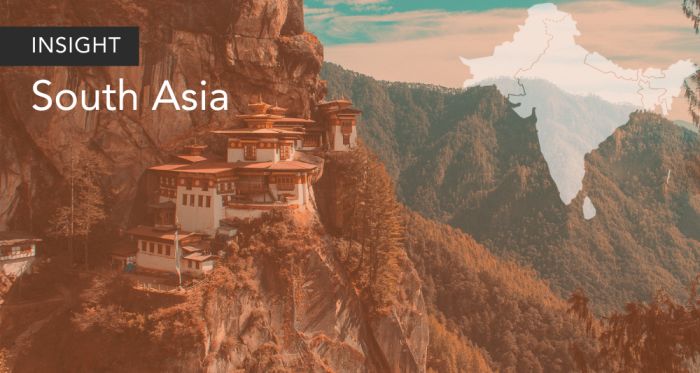The Takeaway
On January 9, voters in Bhutan returned former prime minister Tshering Tobgay's People’s Democratic Party (PDP), which last held power from 2013-18, to office, affirming the party’s position that boosting economic growth is a top priority. The Himalayan country of roughly 775,000 people, famous for its use of a novel development indicator, Gross National Happiness (GNP), has recently battled high unemployment and declining tourism revenues. The election was watched closely by Bhutan’s two competing neighbours: India, which has traditionally viewed Bhutan as part of its sphere of influence, and China, which is seeking to expand its presence in the region.
In Brief
- The general election was the fourth since Bhutan transitioned from an absolute monarchy to a parliamentary democracy in 2008. The liberal-oriented PDP won 30 seats, and the Bhutan Tendrel Party secured the remaining 17 in the country’s 47-member parliament.
- In a preliminary round of voting in November, the ruling centre-left Druk Nyamrup Tshogpa (DNT) party was eliminated as voters chose two parties out of five to contest the final round held on January 9. Since adopting a parliamentary system, the Bhutanese people have voted out the incumbent government in each of its four national elections.
- The recent election was held against the backdrop of crippling challenges to the country’s three-billion-dollar economy, including a youth unemployment rate of 29 per cent and an “exodus” of job-seeking young people in record numbers to foreign countries.
- In October, Bhutan and China held their 25th round of talks in Beijing to resolve a dispute over their 477-kilometre border. A deal to settle the matter, if struck, is expected to lead to Thimphu and Beijing establishing formal diplomatic relations.
- Canada is one of the only two G7 countries (along with Japan) that has diplomatic relations with the Himalayan nation.
Implications
Bhutan is vying to balance economic growth and sustainable development. In 2023, Bhutan reduced its Sustainable Development Fee (SDF), a tourist tax to offset the carbon generated by tourist activity, by 50 per cent, from US$200 per night to US$100, in a bid to help the country’s tourism industry recover from COVID-19 setbacks. The SDF was a major issue in the run-up to the election, exposing tensions between prioritizing economic growth and the imperative of protecting the environment. The PDP’s election campaign promised to review the SDF and remove barriers to growth in the tourism sector.
Bhutan’s economy traditionally receives very limited foreign investment. However, the PDP has promised to increase foreign direct investment (FDI) to C$8 billion (500 billion Bhutanese ngultrums) from the current C$698 million (43 billion Bhutanese ngultrums) by, for example, expanding renewable energy, particularly hydropower and solar farms.
Bhutan must also manage regional power dynamics. India, a long-standing ally of Bhutan and its largest trade and development partner, views the country as a buffer with China. New Delhi “guided” Thimphu’s foreign policy under a 1949 bilateral treaty until as late as 2007, when the treaty was revamped. India has reasons to celebrate last week’s election outcome; outgoing DNT prime minister Lotay Tshering’s apparent eagerness to establish diplomatic relations with China stirred fear in India of Beijing drawing Thimphu closer into its orbit. Tshering’s exit is therefore viewed by Indian observers as a welcome relief.
China has also been courting Bhutan with financial and security assistance through measures like its Global Development Initiative and Global Security Initiative, prompting New Delhi to feel the diplomatic heat. The new Bhutanese government will now face the challenging task of maintaining a balance between the two regional powers.
What’s Next
• What will the final border agreement with China look like?
In 2021, Thimphu and Beijing signed a memorandum of understanding (MoU), which led to a three-step road map to settle their border issues. However, in December 2023, a Chatham House report showed satellite images of Chinese settlements on Bhutan’s disputed northern border. According to the report, Beijing now expects a deal “consolidating its gains,” presumably leading to a permanent Chinese presence in the disputed region. Speculation is rife that Thimphu might accede to Chinese claims due to the seeming irreversibility of the settlements. This would be alarming for New Delhi, which has its own territorial conflict with Beijing.
• Sustainable development initiatives, opportunities for international co-operation
In December, Bhutanese King Jigme Khesar Namgyel Wangchuck announced the Gelephu Mindfulness City Project, a 1,000-square-km Special Administrative Region seen as critical to reversing youth out-migration. This economic centre in Bhutan’s southern border region seeks to draw “non-polluting companies,” focus on sustainable development like harnessing hydropower, and build connectivity for land-locked Bhutan. Viewed as the King’s pet initiative, the project is expected to be prioritized by the new government, as promised by contenders prior to the election.
Bhutan’s sustainable development initiatives may provide an avenue for closer co-operation with international partners. Canada is one of the only two G7 countries (along with Japan) that has diplomatic relations with the Himalayan nation. Efforts to bolster bilateral trade on renewable energy, such as hydropower, and organic food products, appear to be underway. As a developmental partner, Ottawa’s Canada Fund for Local Initiatives has funded development projects in Bhutan for more than four decades.
Produced by APF Canada's South Asia team: Suvolaxmi Dutta Choudhury (Program Manager), Suyesha Dutta (Analyst), and Deeplina Banerjee (Analyst). Editor: Ted Fraser; Translator: Eva Moreta







